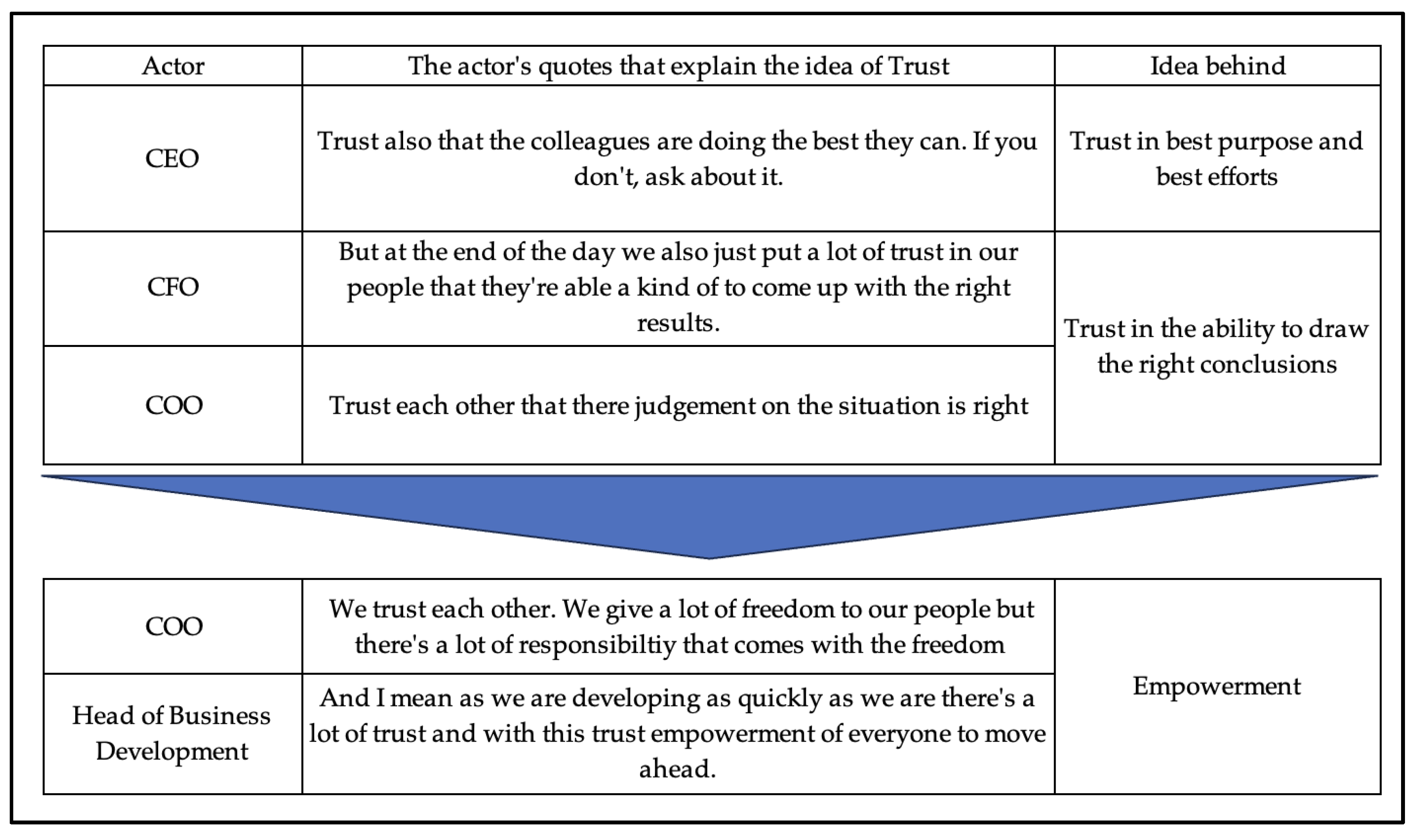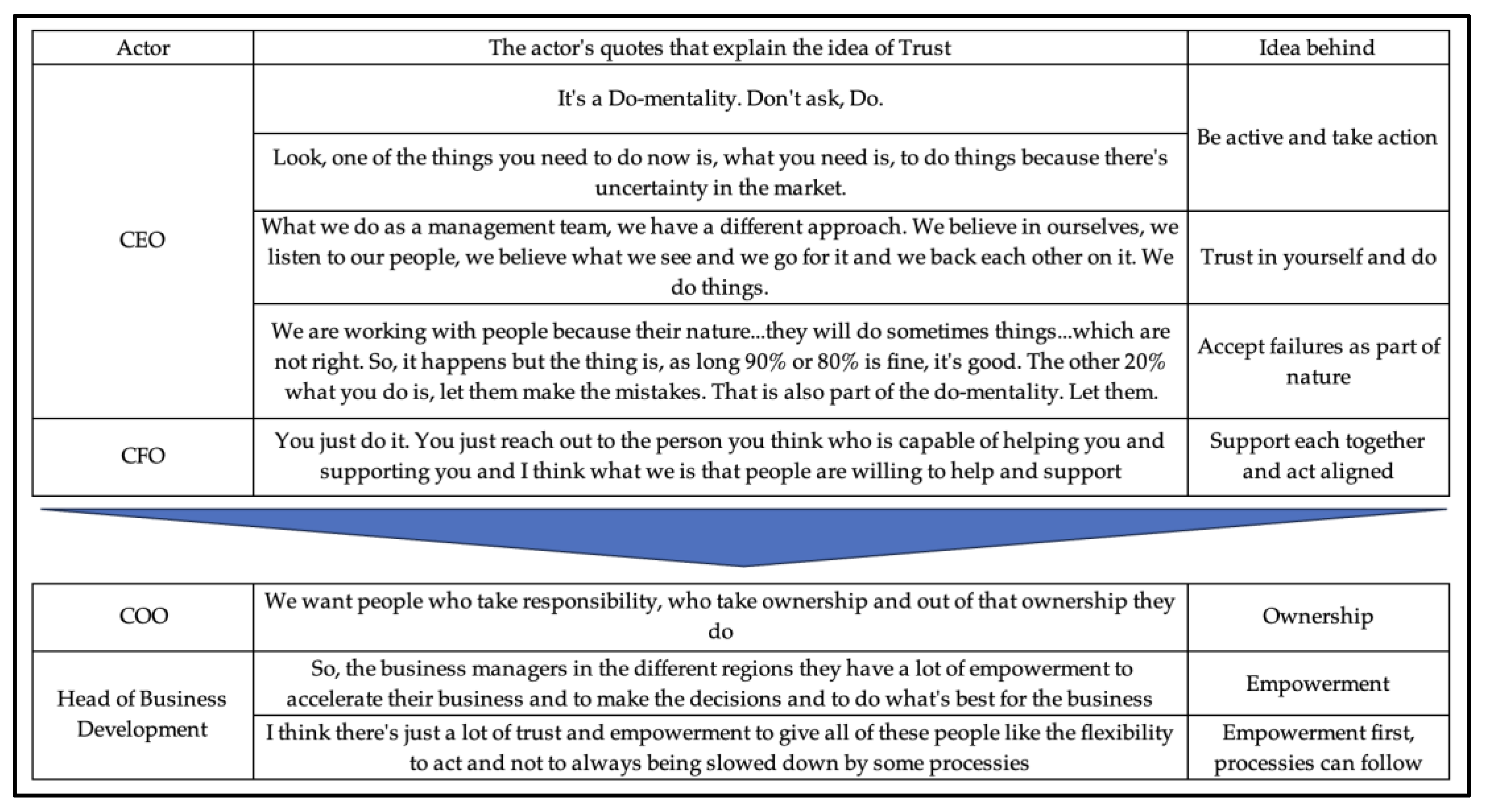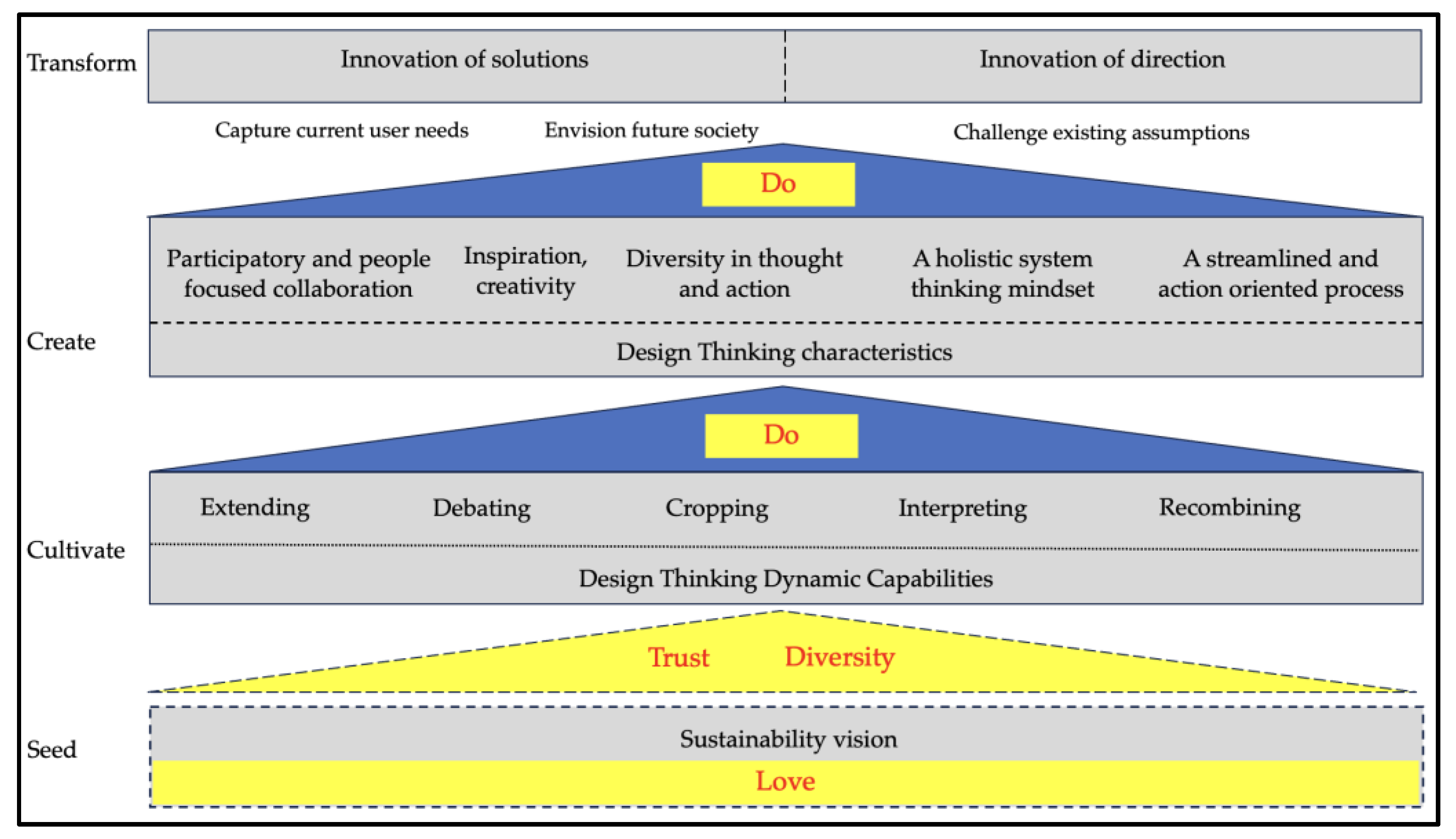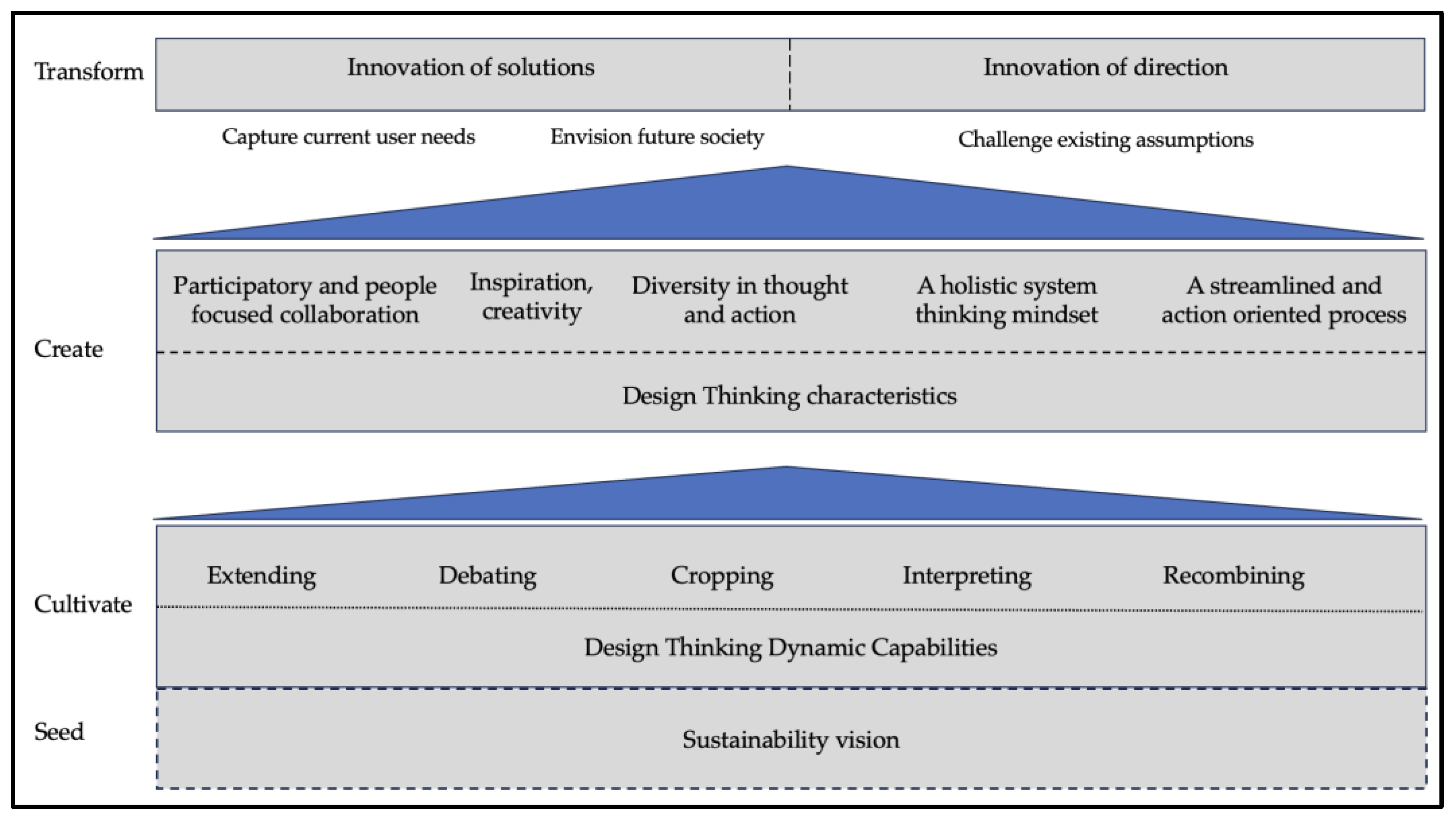Cultivating Design Thinking for Sustainable Business Transformation in a VUCA World: Insights from a German Case Study
Abstract
1. Introduction
- The following Section 2 highlights essential conditions that need to be created at international political level in order to enable sustainable transformations of companies;
- Section 3 presents how Design Thinking cannot only be used for product development but also for sustainable transformations of companies. It further demonstrates how the principles of Industry 5.0 and the idea of ecodesign can transform Design Thinking into a sustainable method;
- Section 4 and Section 5 present a field study at E-Ventures, a company that operates as an operator for electric charging stations in various European countries. This field study identified a specific company DNA (consisting of a purposefully orchestrated staff diversity and a company mantra that affects all levels of the company);
- Section 6 illustrates that this specific company DNA provides organizational key factors to utilize the full potential of Design Thinking for sustainable company transformations and thus answers the research question of this paper;
- Section 7 summarizes the results and discusses the limitations of this study.
2. VUCA Dynamics and Their Development
- A common understanding and a shared vision of the value of sustainability are a prerequisite to utilizing Design Thinking for the sustainable transformation of companies in times of turbulence and VUCA.
- There are still considerable differences in the understanding of the need and value of sustainability at the international level. It is questionable whether the sustainable vision of the SDGs is supported and consistently pursued by international politics and institutions. It can be assumed that this situation will further increase volatility on the markets and that uncertainty for companies will also increase rather than decrease. So, these differences remain a challenge for companies that want to transform themselves sustainably with the help of Design Thinking.
- To enable sustainable transformation, it requires adaptable companies that can implement sustainable visions in these volatile and uncertain environments. Practice shows that adaptable and sustainably operating companies can still thrive in these environments.
3. Design Thinking for Product Development and Business Transformation
- Design Thinking can be utilized not only for product and service innovation, but also for organizational and strategic transformation.
- Design Thinking Dynamic capabilities need to be cultivated to utilize Design Thinking.
- The pursuit of sustainable visions and goals is crucial to establishing Design Thinking as a tool for sustainable transformation. Here, the integration of Industry 5.0 principles into company visions and goals enables sustainable organizational and strategic transformation through Design Thinking, which as a result can strengthen the company’s resilience.
- The integration of Design Thinking with the concept of ecodesign fosters sustainable transformation on the product and service levels.
4. Research Methodology
4.1. Field Research Object
4.2. Field Research Design
- Through a research funnel consisting of four levels, the researchers identified with E-Ventures a suitable research object for which adaptability to uncertain and rapidly changing environments is essential.
- The researchers identified a company operating within megatrends and market environments characterized by turbulence, uncertainty, and acceleration, positioning itself as a pure play company.
- With the help of a case study methodology and theory-generating expert interviews, the researchers tried to find out how the company achieves adaptability.
- In their study, the researchers considered existing concepts while maintaining a degree of openness to identify new ideas.
- Five interviews were conducted with the company’s board members. The theoretical sampling method was used for the interview sampling.
5. Results: The Company’s Organizational DNA
5.1. Diverse Orchestration of Staff
“what my competitors don’t have is our people, …, our management team, the rest you can fill in”.
5.2. Love–Trust–Do
5.2.1. Love
“…Look, you’re going to spend at least 10 h/day here at the office or working. You need to love that… we all love doing this…So, if you ask the two other board members, they’re all sitting here because we wanna do this. I wanna do this…”
“We tried to select the people that fit into that mindset”.
5.2.2. Trust
“We need to build up trust. What I don’t want is that, you know, we do things behind our back, into it. If there’s something, we tell it. If there’s something right, you tell it, if there’s something wrong, you’ll also tell it”.
“We want people who take responsibility, who take ownership and out of that ownership they do.”
5.2.3. Do
“Especially in this new market you have to pivot. The company we built last year will not be the company in 6 years I can definitively tell you that. That’s a given because you pivot. But how do you pivot? It’s not the company who is pivoting it’s people who pivot. They do it…That’s what I believe.”
- The introduced company DNA consists of an intentional, diverse orchestration of staff, from different European countries, that balances young and senior, domain and management expertise, corporate expertise and independent mindsets, and entrepreneurial experience. This orchestration of diversity allows the company to foster holistic, systemic thinking
- Furthermore, E-Ventures’ company DNA consists of the “Love–Trust–Do” mantra that transnationally impacts all levels of the organization. The mantra empowers the company to drive transformation and strengthens the company’s ability to adapt to rapid changing environments
6. Discussion: How E-Ventures’ Organizational DNA Can Drive Business Innovation through Design Thinking
- The E-Ventures DNA, consisting of a purposefully orchestrated diversity of employees in combination with the company mantra “Love–Trust–Do”, impacts all transnational levels of the organization, laying a foundation through which the full potential of Design Thinking can be realized
- The sustainable company vision, which considers the principles of Industry 5.0, is essential for the realization of sustainable transformations through Design Thinking.
7. Conclusions
Author Contributions
Funding
Institutional Review Board Statement
Informed Consent Statement
Data Availability Statement
Conflicts of Interest
References
- United Nations Department of Economic and Social Affairs. The Sustainable Development Goals Report 2023: Special Edition; The Sustainable Development Goals Report; United Nations: New York, NY, USA, 2023. [Google Scholar] [CrossRef]
- United Nations. THE 17 GOALS|Sustainable Development. Sustainable Development Goals History. Available online: https://sdgs.un.org/goals (accessed on 14 November 2023).
- United Nations. SDG Summit 2023; United Nations: New York, NY, USA, 2023; Available online: https://www.un.org/en/conferences/SDGSummit2023 (accessed on 4 December 2023).
- Johansen, B.; Euchner, J. Navigating the VUCA World. Res.-Technol. Manag. 2013, 56, 10–15. [Google Scholar] [CrossRef]
- Santalainen, T. Sustainable Strategizing: Extending Competitive Advantages to Viability Advantage. In Rethinking Strategic Management; Wunder, T., Ed.; CSR, Sustainability, Ethics & Governance; Springer International Publishing: Cham, Switzerland, 2019; pp. 87–104. [Google Scholar] [CrossRef]
- Nowacka, A.; Rzemieniak, M. The Impact of the VUCA Environment on the Digital Competences of Managers in the Power Industry. Energies 2022, 15, 185. [Google Scholar] [CrossRef]
- Gupta, G. Strategic Planning is Dead; Kotter International Inc.: New York, NY, USA, 2023; Available online: https://www.kotterinc.com/strategic-planning-is-dead/ (accessed on 23 May 2023).
- Bender-Salazar, R. Design Thinking as an Effective Method for Problem-Setting and Needfinding for Entrepreneurial Teams Addressing Wicked Problems. J. Innov. Entrep. 2023, 12, 24. [Google Scholar] [CrossRef]
- Meinel, C.; Leifer, L. (Eds.) Design Thinking Research: Innovation—Insight—Then and Now; Understanding Innovation; Springer Nature Switzerland: Cham, Switzerland, 2023. [Google Scholar] [CrossRef]
- Magistretti, S.; Bianchi, M.; Calabretta, G.; Candi, M.; Dell’Era, C.; Stigliani, I.; Verganti, R. Framing the Multifaceted Nature of Design Thinking in Addressing Different Innovation Purposes. Long Range Plan. 2022, 55, 102163. [Google Scholar] [CrossRef]
- Rösch, N.; Tiberius, V.; Kraus, S. Design Thinking for Innovation: Context Factors, Process, and Outcomes. Eur. J. Innov. Manag. 2023, 26, 160–176. [Google Scholar] [CrossRef]
- Leng, J.; Sha, W.; Wang, B.; Zheng, P.; Zhuang, C.; Liu, Q.; Wuest, T.; Mourtzis, D.; Wang, L. Industry 5.0: Prospect and Retrospect. J. Manuf. Syst. 2022, 65, 279–295. [Google Scholar] [CrossRef]
- Stockholm Environment Institute; Climate Analytics; E3G; International Institute for Sustainable Development; UN Environment Programme. The Production Gap: Phasing Down or Phasing Up? Top Fossil Fuel Producers Plan Even More Extraction despite Climate Promises; Stockholm Environment Institute: Stockholm, Sweden, 2023. [Google Scholar] [CrossRef]
- Greenpeace-Studie: Europas Ölkonzerne Investieren Unbeirrt Weiter in Erderhitzung; Greenpeace Deutschland Pressemitteilungen: Hamburg, Germany, 2023; Available online: https://presseportal.greenpeace.de/229097-greenpeace-studie-europas-olkonzerne-investieren-unbeirrt-weiter-in-erderhitzung (accessed on 17 November 2023).
- Reuters. What Are They Saying at the U.N. Climate Summit? 1 December 2023. Available online: https://www.reuters.com/business/environment/cop28-what-are-they-saying-un-climate-summit-2023-12-01/ (accessed on 4 December 2023).
- Dubai: COP28-Präsident Hält Fossilen Ausstieg für Unnötig—Schlechte Luft Während der Konferenz—WELT; DIE WELT: Berlin/Heidelberg, Germany, 2023; Available online: https://www.welt.de/politik/ausland/article248858420/Dubai-COP28-Praesident-haelt-fossilen-Ausstieg-fuer-unnoetig-Schlechte-Luft-waehrend-der-Konferenz.html (accessed on 4 December 2023).
- United Nations. Goal 15|Department of Economic and Social Affairs. Available online: https://sdgs.un.org/goals/goal15 (accessed on 4 December 2023).
- Bundesamt für Naturschutz. Auswirkungen von Glyphosat auf die Biodiversität. 2018. Available online: https://www.bfn.de/sites/default/files/2021-04/20180131_BfN-Papier_Glyphosat.pdf (accessed on 17 November 2023).
- Bainbridge, W.S.; Roco, M.C. (Eds.) Handbook of Science and Technology Convergence; Springer International Publishing: Cham, Switzerland, 2016. [Google Scholar] [CrossRef]
- Scott, M. The 100 Most Sustainable Companies of 2023; Corporate Knights: London, UK, 2023; Available online: https://www.corporateknights.com/rankings/global-100-rankings/2023-global-100-rankings/2023-global-100-most-sustainable-companies/ (accessed on 27 February 2024).
- He, J.; Ortiz, J. Sustainable Business Modeling: The Need for Innovative Design Thinking. J. Clean. Prod. 2021, 298, 126751. [Google Scholar] [CrossRef]
- Magistretti, S.; Pham, C.T.A.; Dell’Era, C. Enlightening the Dynamic Capabilities of Design Thinking in Fostering Digital Transformation. Ind. Mark. Manag. 2021, 97, 59–70. [Google Scholar] [CrossRef]
- Tavanti, M. Developing Sustainability in Organizations: A Values-Based Approach; Sustainable Development Goals Series; Springer International Publishing: Cham, 2023. [Google Scholar] [CrossRef]
- Meisiek, S.; Beausoleil, A.M.; Barry, D.; Dattani, A. Gaining Flexibility in Expertise through Executive Education: Tuning Schemas in Design Thinking. AMLE 2023, 22, 574–594. [Google Scholar] [CrossRef]
- Magistretti, S.; Dell’Era, C.; Cautela, C.; Kotlar, J. Design Thinking for Organizational Innovation at PepsiCo. Calif. Manag. Rev. 2023, 65, 5–26. [Google Scholar] [CrossRef]
- Magistretti, S.; Bellini, E.; Cautela, C.; Dell’Era, C.; Gastaldi, L.; Lessanibahri, S. The Perceived Relevance of Design Thinking in Achieving Innovation Goals: The Individual Microfoundations Perspective. Creat. Innov. Manag. 2022, 31, 740–754. [Google Scholar] [CrossRef]
- Santa-Maria, T.; Vermeulen, W.J.V.; Baumgartner, R.J. The Circular Sprint: Circular Business Model Innovation through Design Thinking. J. Clean. Prod. 2022, 362, 132323. [Google Scholar] [CrossRef]
- Habicher, D.; Erschbamer, G.; Pechlaner, H.; Ghirardello, L.; Walder, M. Transformation and Design Thinking: Perspectives on Sustainable Change, Company Resilience and Democratic Leadership in SMEs. Leadersh. Educ. Personal. Interdiscip. J. 2021, 3, 145–156. [Google Scholar] [CrossRef]
- Gould, R.K.; Bratt, C.; Lagun Mesquita, P.; Broman, G.I. Integrating Sustainable Development and Design-Thinking-Based Product Design. In Technologies and Eco-Innovation towards Sustainability I: Eco Design of Products and Services; Hu, A.H., Matsumoto, M., Kuo, T.C., Smith, S., Eds.; Springer: Singapore, 2019; pp. 245–259. [Google Scholar] [CrossRef]
- Gumulya, D.; Andriato, T. Eco-Design Strategy within Design Thinking Framework for Children’s Furniture at Lentera Harapan School Rote, NTT: A Case Study; Atlantis Press: Paris, France, 2020; pp. 193–202. [Google Scholar] [CrossRef]
- ISO 14006:2020(en); Environmental Management Systems—Guidelines for Incorporating Ecodesign. Online Browsing Platform ISO Standards. International Organization for Standardization: Geneva, Switzerland, 2024. Available online: https://www.iso.org/obp/ui#iso:std:iso:14006:ed-2:v1:en (accessed on 31 January 2024).
- Arana-Landin, G.; Sigüenza, W.; Landeta-Manzano, B.; Laskurain-Iturbe, I. Circular Economy: On the Road to ISO 59000 Family of Standards. In Corporate Social Responsibility and Environmental Management; Wiley: Hoboken, NJ, USA, 2023; pp. 1–33. [Google Scholar] [CrossRef]
- Heras-Saizarbitoria, I.; Boiral, O.; Testa, F. ISO 59000 Standards for the Circular Economy: A Call for Accuracy; Elsevier: Rochester, NY, USA, 2023. [Google Scholar] [CrossRef]
- ISO/DIS 59014(en); Environmental Management and Circular Economy—Sustainability and Traceability of Secondary Materials Recovery—Principles and Requirements. International Organization for Standardization: Geneva, Switzerland, 2024. Available online: https://www.iso.org/obp/ui#iso:std:iso:59014:dis:ed-1:v1:en (accessed on 26 February 2024).
- Schwager, B. (Ed.) CSR und Nachhaltigkeitsstandards: Normung und Standards im Nachhaltigkeitskontext; Management-Reihe Corporate Social Responsibility; Springer: Berlin/Heidelberg, Germany, 2022. [Google Scholar] [CrossRef]
- Horn, S.; Salo, H.; Nissinen, A. Promoting Ecodesign Implementation: The Role and Development Areas of National Public Policy. Environ. Policy Gov. 2023, 33, 474–488. [Google Scholar] [CrossRef]
- Landeta-Manzano, B.; Arana-Landín, G.; Jimenez-Redal, R.; Uriarte-Gallastegi, N. Effects of the Inclusion of Life Cycle Thinking in the ISO 14001. In IoT and Data Science in Engineering Management; García Márquez, F.P., Segovia Ramírez, I., Bernalte Sánchez, P.J., Muñoz del Río, A., Eds.; Lecture Notes on Data Engineering and Communications Technologies; Springer International Publishing: Cham, Switzerland, 2023; pp. 255–260. [Google Scholar] [CrossRef]
- Van Doorsselaer, K. Chapter 12—The Role of Ecodesign in the Circular Economy. In Circular Economy and Sustainability; Stefanakis, A., Nikolaou, I., Eds.; Elsevier: Amsterdam, The Netherlands, 2022; pp. 189–205. [Google Scholar] [CrossRef]
- Niehaus, M.; Hansen, K.; Mocan, M.; Barmayoun, D. Unraveling Successful Company Organizations: A Research Design to Explore Strategies for Thriving Amid Market Turbulence. Adm. Sci. 2023, 13, 204. [Google Scholar] [CrossRef]
- Zukunftsinstitut. Megatrend-Map. Available online: https://www.zukunftsinstitut.de/artikel/die-megatrend-map/ (accessed on 29 September 2022).
- Zukunftsinstitut. Der Megatrend Neo-Ökologie. Megatrend Neo-Ökologie. Available online: https://www.zukunftsinstitut.de/dossier/megatrend-neo-oekologie/ (accessed on 2 August 2023).
- Zukunftsinstitut. Mobilität Glossar. Glossar Mobilität: Trendbegriffe und Definitionen. Available online: https://www.zukunftsinstitut.de/artikel/megatrend-glossar/mobilitaet-glossar/ (accessed on 12 June 2023).
- eMobility—In-Depth Market Insights & Analysis, 2022. Available online: https://de.statista.com/statistik/studie/id/49256/dokument/emobility-market-insights-und-analysis/ (accessed on 12 June 2023).
- Statista. Elektromobilität in Deutschland—Fokus Pkw. Available online: https://de.statista.com/statistik/studie/id/6547/dokument/elektromobilitaet/ (accessed on 8 May 2023).
- Otto, H.; Sponring, M.; Freier, S. Elektromobilität—Ein Zukunftsfähiges Geschäftsmodell für Energieversorger? 2018. Available online: https://de.statista.com/statistik/studie/id/67134/dokument/studie-zur-sicht-auf-die-e-mobilitaet-in-deutschland-2019/ (accessed on 12 June 2023).
- Bratzel, S.; Tellermann, R. Die Zukunft der Mobilität—Die Zukunftstrends in den Bereichen Elektromobilität, Connected Car und Mobilitätsdienstleistungen; Study; Center of Automotive Management: Bergisch Gladbach, Germany, 2022; Available online: https://de.statista.com/statistik/studie/id/132369/dokument/studie-zur-zukunft-der-mobilitaet/ (accessed on 12 June 2023).
- Statista. Verbraucherpreisindex für Elektrizität bis 2022. Available online: https://de.statista.com/statistik/daten/studie/1301975/umfrage/verbraucherpreisindex-elektrizitaet-in-deutschland/ (accessed on 9 May 2023).
- Viguerie, P.; Calder, N.; Hindo, B. 2021 Corporate Longevity Forecast. Innosight. Available online: https://www.innosight.com/insight/creative-destruction/ (accessed on 5 June 2023).
- Eisenhardt, K.M. Building Theories from Case Study Research. Acad. Manag. Rev. 1989, 14, 532–550. [Google Scholar] [CrossRef]
- Teece, D.J. Dynamic Capabilities: Routines versus Entrepreneurial Action. J. Manag. Stud. 2012, 49, 1395–1401. [Google Scholar] [CrossRef]
- Mayring, P. Einführung in Die Qualitative Sozialforschung, 7th ed.; Beltz Verlagsgruppe: Weinheim, Germany, 2023. [Google Scholar]
- Bogner, A.; Littig, B.; Menz, W. Interviews mit Experten: Eine praxisorientierte Einführung; Springer Fachmedien: Wiesbaden, Germany, 2014. [Google Scholar] [CrossRef]
- Kuckartz, U.; Rädiker, S. Qualitative Inhaltsanalyse. Methoden, Praxis, Computerunterstützung; Beltz Juventa: Weinheim, Germany, 2022. [Google Scholar]
- Glaser, B.G.; Strauss, A.L. Grounded Theory: Strategien Qualitativer Forschung. The Discovery of Grounded Theory, 2., Korrigierte Aufl.; Huber: Bern, Switzerland, 2005. [Google Scholar]
- Teece, D.J. Explicating Dynamic Capabilities: The Nature and Microfoundations of (Sustainable) Enterprise Performance. Strateg. Manag. J. 2007, 28, 1319–1350. [Google Scholar] [CrossRef]
- Hasso Plattner Institute of Design. Navigating Ambiguity|Library of Ambiguity|d.school Public Library. Available online: https://dlibrary.stanford.edu/navigating-ambiguity (accessed on 20 November 2023).
- Kolko, J. Abductive Thinking and Sensemaking: The Drivers of Design Synthesis. Des. Issues 2010, 26, 15–28. [Google Scholar] [CrossRef]
- Design Project Scoping Guide|Library of Ambiguity|d.School Public Library, 2018. Available online: https://dlibrary.stanford.edu/ambiguity/design-project-scoping-guide (accessed on 20 November 2023).
- Stanford d.school. Hasso Plattner Institute of Design. A Place for Explorers & Experimenters at Stanford University, Design Abilities. Available online: https://dschool.stanford.edu/about (accessed on 15 December 2023).




| Quote From | Description of Diversity Sourcing (Quote Level) | Characteristic | Type of Diversity |
|---|---|---|---|
| CEO | It’s a couple of elements: Young and senior, you see that here. You’ve a couple of young people which are thriving, doing great things but you also need some more senior people, you know to have that balanced off. So, that is one key element you see over here is what you see in the mixture is young vs. senior. | Age | Young and Senior |
| CFO | I think it’s quite a mixture of also just people that have a very long standing experience, are very much experts in their area but also just a lot of young people who bring a lot of, kind of new ideas into it and are willing to also just go a new path and take new ways bascially that which are not told in the past that you’ve done if you’ve already been working like in an organization for the last 15 years and I think that brings together I think quite a good mixture of people who really can push the business forward. | Age | |
| CEO | - He is very good in processes, he knows everything in processes - …domain expert, he is the Wikipedia. If you wanna know anything about this business ask him, this is domain knowledge. -So, you walk around you will see a couple of people which are really domain experts because you can’t operate in a market if you don’t know anything about the market. If I wanna know:” Hey, how is the charger? I wanna be able to go walk to somebody and say:” Listen, how does the charger work?” So, you need domain expertise. | Domain Expertise | Domain expertise and management expertise |
| CEO | You also need managers who know how to manage. So, that’s another element which is very key for me where I find a balance into it. So, you have domain experts and you managers. | Management Expertise | |
| CFO | I think one thing is, I think it’s a mix really of people who are from the mother company with a background in the mother company because finally a spin-off basically but also people coming from elsewhere, not having a kind of the mother company background. | Corporate network | Corporate Experience and Independent mindset and experience |
| CFO | And as we are generally an organisation who wants to be stand alone…it’s also important to have people that don’t have that background and don’t kind of also may be feel tied to the mother company and also question why for instance we should favor the mother company over some other supplier at the end of the day. | Independent mindset and experience | |
| CEO | - …Although we are arms length we have an own company, we wanna use them, like for their customers…So, that corporate experience is very important because we are part of it, although we are arms length. - It’s the real network into it but the other element is also very important, don’t forget that. How do we keep the corporate far away from us…and that’s why that corporate experience is so important because we couldn’t do that if we didn’t have that experience. - We call it arms length. So, it really needs to be arms length and loosely coupled with and protected the people | Corporate network Corporate experience | |
| COO | - We need to know how a corporate function works - And I think, I fully agree, very important that we do that and separate ourselves from the corporate without losing the connection | Corporate Experience | |
| COO | - …don’t underestimate that factor. So, dealing with decision making in uncertain environment, dealing with the feeling of “it’s our money that we are investing, it’s my company” and the ownership and the feeling that is behind that. - …especially in a scale-up that we are that you have somebody with that entrepreneurial experience. - There you have the entrepreneurship, to inspire people, to be able to stand in the spotlight and everyone wants to work with him and wants to follow because of his way of doing things…to connect to partners, to connect to customers. When customer conversations become very difficult we him in and he breaks it open somehow. Because of his way of doing things and connecting to people… | Entrepreneurial Experience | Entrepreneurial Experience |
| Actor | The Actor’s Quotes That Explain the Idea of Love | Idea Behind |
|---|---|---|
| CEO | For me it’s you need to love to work here. That’s it you know. It’s because you’re passionate about this industry. | Passion and commitment |
| COO | We love what we do. We know we can only be successful when we have people who love what they do, they enjoy their work, going to work every day, that are having fun doing it | Love creates success |
Disclaimer/Publisher’s Note: The statements, opinions and data contained in all publications are solely those of the individual author(s) and contributor(s) and not of MDPI and/or the editor(s). MDPI and/or the editor(s) disclaim responsibility for any injury to people or property resulting from any ideas, methods, instructions or products referred to in the content. |
© 2024 by the authors. Licensee MDPI, Basel, Switzerland. This article is an open access article distributed under the terms and conditions of the Creative Commons Attribution (CC BY) license (https://creativecommons.org/licenses/by/4.0/).
Share and Cite
Niehaus, M.; Mocan, M. Cultivating Design Thinking for Sustainable Business Transformation in a VUCA World: Insights from a German Case Study. Sustainability 2024, 16, 2447. https://doi.org/10.3390/su16062447
Niehaus M, Mocan M. Cultivating Design Thinking for Sustainable Business Transformation in a VUCA World: Insights from a German Case Study. Sustainability. 2024; 16(6):2447. https://doi.org/10.3390/su16062447
Chicago/Turabian StyleNiehaus, Markus, and Marian Mocan. 2024. "Cultivating Design Thinking for Sustainable Business Transformation in a VUCA World: Insights from a German Case Study" Sustainability 16, no. 6: 2447. https://doi.org/10.3390/su16062447
APA StyleNiehaus, M., & Mocan, M. (2024). Cultivating Design Thinking for Sustainable Business Transformation in a VUCA World: Insights from a German Case Study. Sustainability, 16(6), 2447. https://doi.org/10.3390/su16062447











